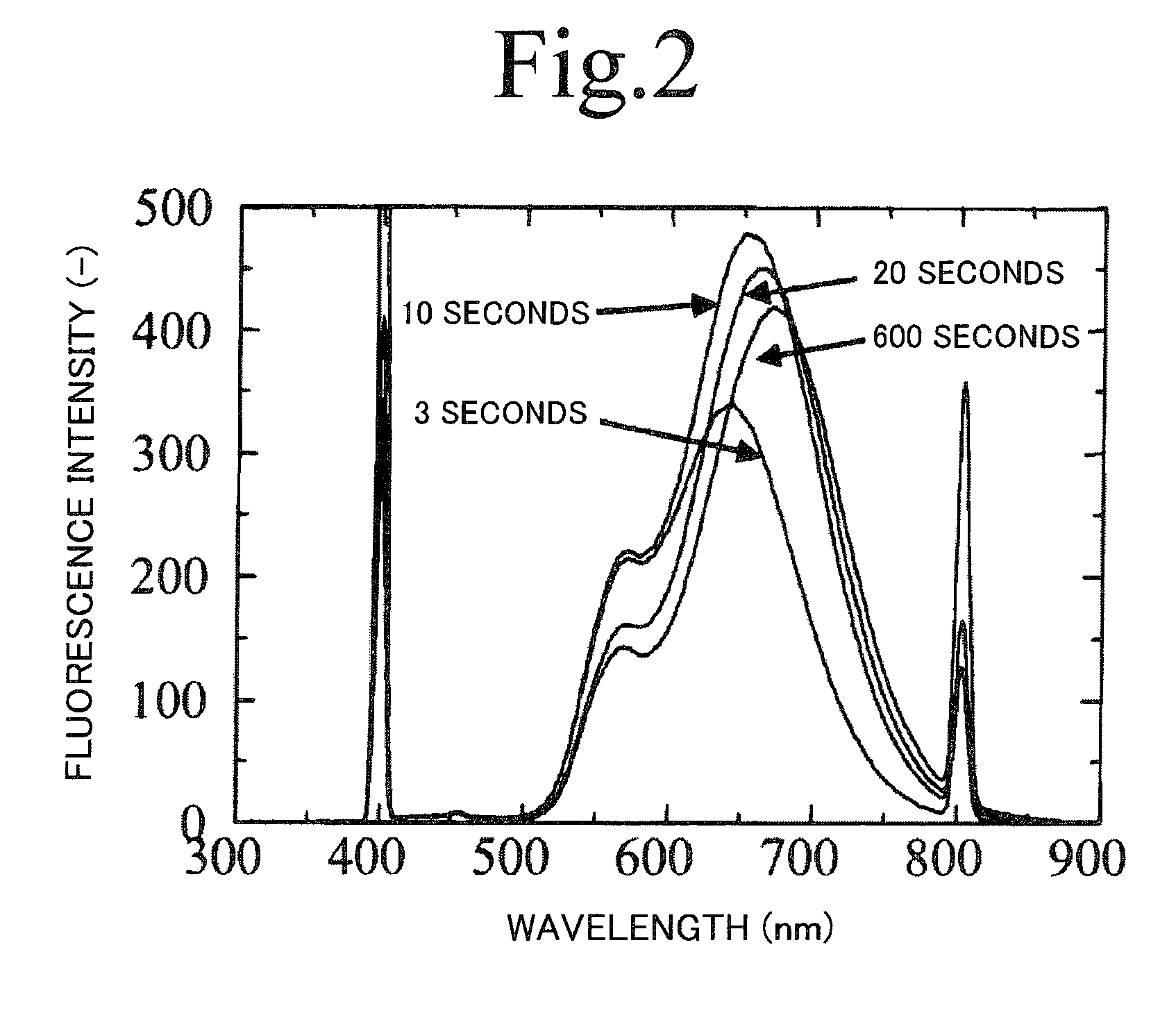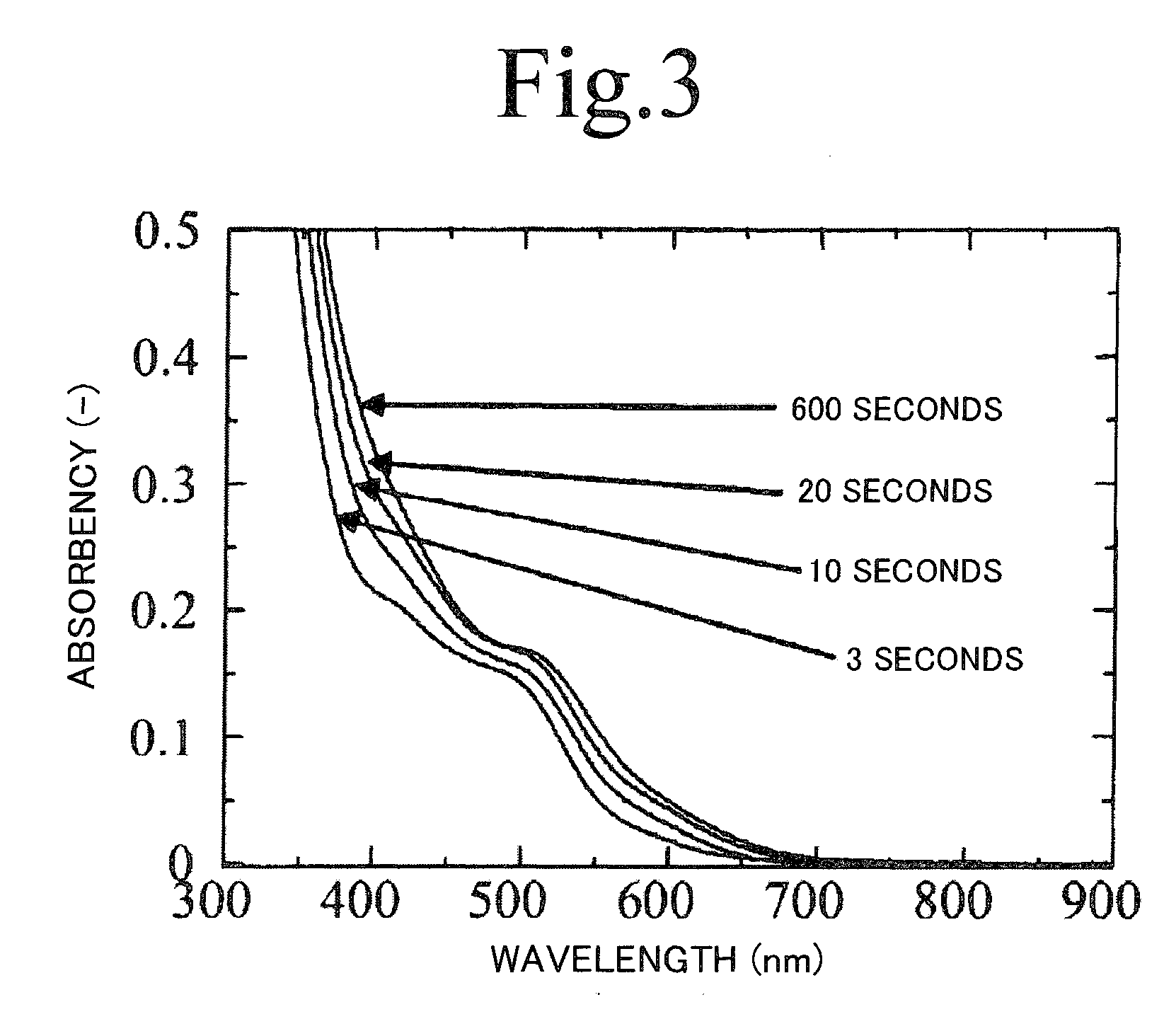Fluorescent and method for producing the same
- Summary
- Abstract
- Description
- Claims
- Application Information
AI Technical Summary
Benefits of technology
Problems solved by technology
Method used
Image
Examples
example 1
CIS
[0078]Here, Example 1 for producing the fluorescent of the present invention will now be described. Reaction solutions were all prepared under argon atmosphere using argon gas. Copper iodide (I) and indium iodide (III) were dissolved at a concentration of 0.017 mol / L in oleylamine which is a complexing agent, to obtain a solution A. Oleylamine is a basic organic solvent and a coordinating solvent, and was used as a complexing agent for a metal ion and a stabilizing agent by coordinating the surface of a generated particle to prevent particle aggregation (this is the same for the following examples).
[0079]Thioacetamide was dissolved at a concentration of 0.034 mol / L in trioctyl phosphine to obtain a solution C. A reaction solution with a mixture of 18 mL of the solution A and 18 mL of the solution C was basically ripened for 24 hours at a temperature of 25° C. under argon atmosphere. Thereafter, the reaction solution was heated and reacted for 3 seconds to 10 minutes at a temperat...
example 2
[0101]Here, Example 2 for producing the fluorescent of the present invention will now be described. Reaction solutions were all prepared under argon atmosphere using argon gas. Copper iodide and indium iodide were dissolved at a concentration of 0.017 mol / L in a mixed solution of octadecene and oleylamine which is a complexing agent, to obtain a solution A. The mixing ratio is X (%)=100×oleylamine / (octadecene+oleylamine), where X=100%, 50% and 10%.
[0102]Thioacetamide was dissolved at a concentration of 0.034 mol / L in trioctyl phosphine to obtain a solution C. A reaction solution with a mixture of 18 mL of the solution A and 18 mL of the solution C was ripened for 24 hours at a temperature of 25° C., and then heated for 3 seconds to 10 minutes at temperatures of 160° C., 200° C., and 240° C. Note that heating for 3 seconds to 2 minutes was performed using a microreactor having an inner diameter of 200 μm. Thus obtained products were diluted with toluene, and absorbency / fluorescence s...
example 3
Effects of Addition of Gallium
[0105]Here, Example 3 for producing the fluorescent of the present invention will now be described. Reaction solutions were all prepared using argon gas under argon atmosphere. Gallium iodide, copper iodide, and indium iodide were dissolved in oleylamine which is a complexing agent, to obtain a solution A. Note that copper iodide was dissolved at a concentration of 0.017 mol / L. Furthermore, gallium iodide and indium iodide were mixed at a mixing ratio of 1−X:X, where X=0, 0.2, 0.4, 0.6, 0.8 and 1.0, so that [the concentration of] the both becomes 0.017 mol / L.
[0106]Thioacetamide was dissolved at a concentration of 0.034 mol / L in trioctyl phosphine to obtain a solution C. A reaction solution with a mixture of 18 mL of the solution A and 18 mL of the solution C was ripened for 24 hours at a temperature of 25° C., and then heated for 3 seconds to 10 minutes at temperatures of 160° C., 200° C., and 240° C. Note that heating for 3 seconds to 2 minutes was per...
PUM
 Login to View More
Login to View More Abstract
Description
Claims
Application Information
 Login to View More
Login to View More - R&D
- Intellectual Property
- Life Sciences
- Materials
- Tech Scout
- Unparalleled Data Quality
- Higher Quality Content
- 60% Fewer Hallucinations
Browse by: Latest US Patents, China's latest patents, Technical Efficacy Thesaurus, Application Domain, Technology Topic, Popular Technical Reports.
© 2025 PatSnap. All rights reserved.Legal|Privacy policy|Modern Slavery Act Transparency Statement|Sitemap|About US| Contact US: help@patsnap.com



